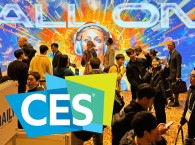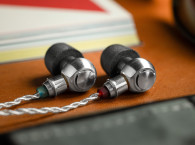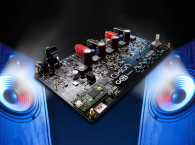As I reported last week, under the difficult circumstances of a show attended by very few people, and with many participating remotely, it's hard to understand that some really important stories for our CES report reached us by mid to end of the second day. It's as if some companies attending CES suddenly realized at the end of the second day, "Oops, we forgot to tell people we are here." Honestly, during a normal show until CES 2020, two years ago, I wouldn't even notice and I would certainly not complain since I would just be too busy working the show in Las Vegas. Under these circumstances of this hybrid, in-person and virtual format, it felt like watching a movie through a peephole and trying to make sense of the plot.
And after Friday, January 7, it seemed like everyone was busy traveling back, quarantining in hotels, or just using the opportunity to visit the Grand Canyon - and everything went silent. Unlike what I expected, our email inbox went quiet before the show was over on Friday and it's been mostly quiet since then.
Also, unlike what I expected, it seems no one is using the online platform that CES created to extend the event for several weeks - as they could and should. So, essentially, there was a lot of teasing, promises, stuff that was unveiled... and finally little else happened. In short, CES fell short.
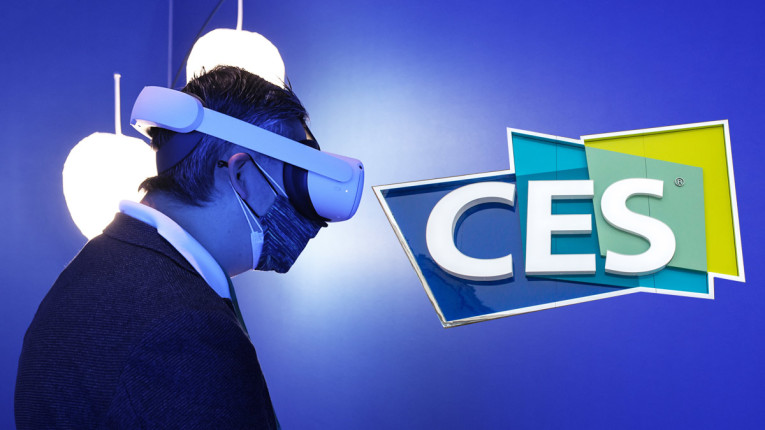
This was reported by our brave "boots on the ground" (thanks Roger and Steve!) - our team members who actually made it to Vegas and reported how hectic the whole experience was at the start, and how empty it started to feel very quickly. So, mixed feelings about this.
I still believe the CTA did well in pushing the show forward, but in the end it seems that the pandemic won. Actually, I'm not surprised that other scheduled large shows are being postponed after CES (e.g., ISE just did), and I am starting to doubt that Mobile World Congress MWC22 (February 28 - March 3) in Barcelona is going to happen.
The CTA sent out an overly rosy balance release of CES 2022, repeating the official pre-event stats (2300 exhibitors) and confirming that, "well over 40,000 attendees in person, including 1800 global media, across 11 indoor and outdoor venues," had made this show "a global event, with 30% of attendees traveling from outside the US – representing 119 countries." Most of those international exhibitors and attendees used CES as an excuse to finally travel and visit their clients, partners, and suppliers, before and after the show. Also, because after two years many are struggling to keep their frequent flyer status...
Yes, of course people were overjoyed by attending - the ones that did - and CES 2022 "furthered global business" as Gary Shapiro stated. Automotive technology, health, and the startups areas were clearly the main highlights for CES 2022. Will there be significant results from this? Very hard to tell. CES 2022 certainly helped set the standard for health protocols in place for in-person attendance - proof of vaccination, required masking indoors, testing, and social distancing measures - which we have not seen in previous attempts of trade shows in 2021. Anyway, enough complaining!
There were interesting announcements at CES 2022 that we will need to follow. For an audio industry publication obviously the biggest frustration is that we couldn't listen! So, we reserve the judgements to brief impressions reported by our friends and colleagues on site who hardly had the time to find the demos I suggested. But I decided I should briefly highlight a few audio presentations that deserve recognition and attention.

Noveto: Technology 10, Product 4
I'll start with Noveto, the company from Israel that we have highlighted multiple times since we first saw them at CES 2018. Noveto was showing its N1 speaker, strangely promoted by its marketing team as "an immersive 3D audio invisible headphone," promising "a new form of audio listening set to transform work and comfort for the modern professional."
The Noveto N1 speaker, as audioXpress reported is in reality a proof-of-concept implementation that Noveto promoted on crowdfunding platforms as a consumer-oriented product, and that was the big focus at CES 2022. The marketing pitch was quickly replicated by the usual gadget-tech quick-bait websites - which didn't attend the show, so not a surprise... When marketing targets a strategy in the wrong direction, there's always the risk that it works.
In reality, the demo was not very impressive and the reproduction was reported to audioXpress as "thin" and limited in frequency - which is not very promising for consumers expecting "invisible headphones." The booth seemed busy because the company was offering free espresso coffee (smart move!) In reality, what the Noveto N1 speaker concept shows is that the technology works, and is impressive and very promising for voice applications and communications (for now).
Noveto’s proprietary smart audio beaming technology transmits ultrasound silently through the air, converging into audible pockets just outside the listener's ears. That part works and it's impressive in itself! Potential applications in automotive, office communications in open spaces, videoconference in general, even individual fitness training in gyms, could and should be the target. Basically, any situation that requires hands-free, private communications, while maintaining environmental awareness.
The Noveto N1 speaker will likely find a market in these situations since it will be available soon - it is in the final stages of mass production with the assistance of Noveto’s strategic partner, Foxconn. And Noveto’s proprietary software and chipset is available for licensing.
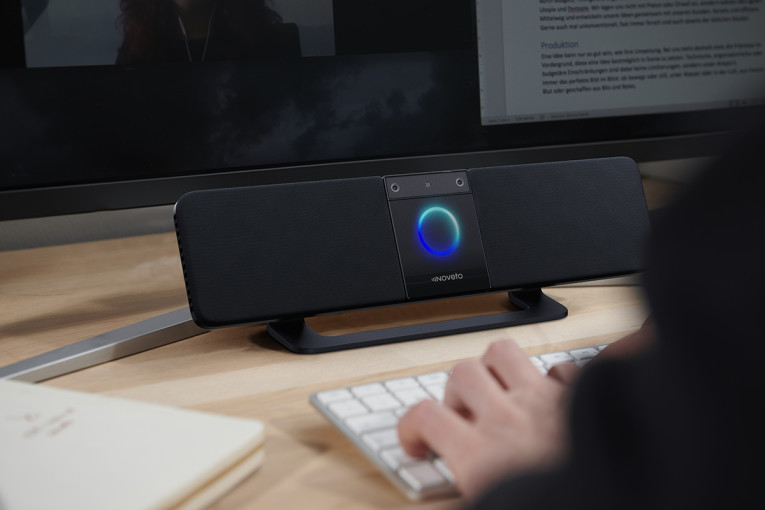

Exeger Powerfoyle Steals CES2022
Next on our list is Mayht and Exeger. As audioXpress reported, Swedish company Exeger - the company behind the Powerfoyle solar cell material already powering self-charging consumer electronic devices - invested in the innovative Dutch audio-tech start-up, Mayht. And Mayht was showing for the first time in public a series of different concepts for its Heartmotion speaker driver technology.
But let's start with Exeger, which was showing Powerfoyle at CES 2022 - which means that we can expect to see many future products using this solar cell material that converts all forms of light into electrical energy. Powerfoyle is a flexible material that can be seamlessly integrated into all consumer electronics products that benefit from being self-powered - headphones being an ideal application. Powerfoyle was a CES Innovation Award Honoree in the Sustainability, Eco-Design & Smart Energy category.
Since I couldn't be in Las Vegas and this was one of the companies I was most looking forward to see there, I have ordered my own Urbanista Los Angeles solar-powered headphones with ANC the moment I had to cancel my flights to Vegas. I have been using it these past few days and by simply keeping the headphones out of the box (they ship with a very smart protective case that keeps the Powerfoyle covered headband always exposed) I have not yet had to plug the headphones to a charger. The headphones are able to convert all light, outdoor and indoor, and they remain at 70% capacity most of the time. And using the Urbanista app, I can see in real time the effect that different light intensities have on the battery. Excellent!
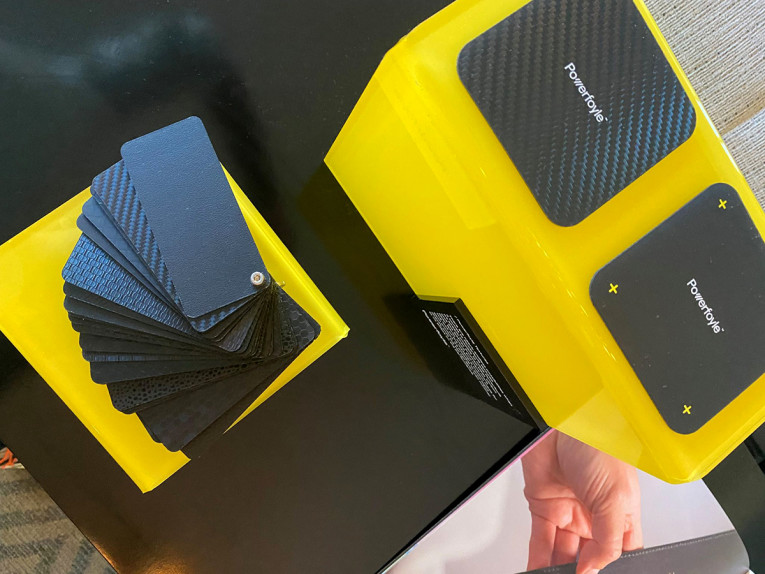
I actually had a Zoom call with the Mayht team before CES opened. The Dutch company was exhibiting in a suite at the Cosmopolitan hotel, where Exeger was also based, and during my call I could see that they were demonstrating an exciting range of speakers using their Heartmotion technology. One of those demos was a "truly wireless" speaker using Exeger’s Powerfoyle material on the back of the cabinet. The prototype was kept playing at CES 2022 and is a great example to showcase how consumer electronics brands can benefit from both technologies in future portable designs with infinite playtime.
The prototype of the battery-powered speaker used Mayht's i5 midbass driver (transparent to allow a better understanding of the HeartMotion mechanics) in a 3L sealed enclosure. By combining Powerfoyle with this HeartMotion speaker that provides 4x less power consumption, the reference design was able to provide a response from 40Hz to 20kHz, complemented with a standard, small-size, full-range driver.
The remaining demonstrations served to highlight the advantages of the Heartmotion drivers in different form-factors - each driver uses two membranes moving in opposing directions to increase air displacement capability and prevent mechanical resonance of an enclosure, resulting in much thinner and smaller products, or with up to 10x more output relative to size.
At CES 2022, Mayht was demonstrating advanced reference designs using these drivers that are cost-optimized for every application. Starting with a demonstration of a voice-optimized Bluetooth speaker using its smallest T1 design, a larger portable speaker and a soundbar using the midbass T3 drivers, complemented with standard full-range drivers, and very promising subwoofer and stackable sub arrays, using the larger Heartmotion T5 driver that responds from as low as 25Hz in different configurations. The Mayht team was visibly excited with the interest already generated in the market, and they expect to have some licensing deals in place very soon.
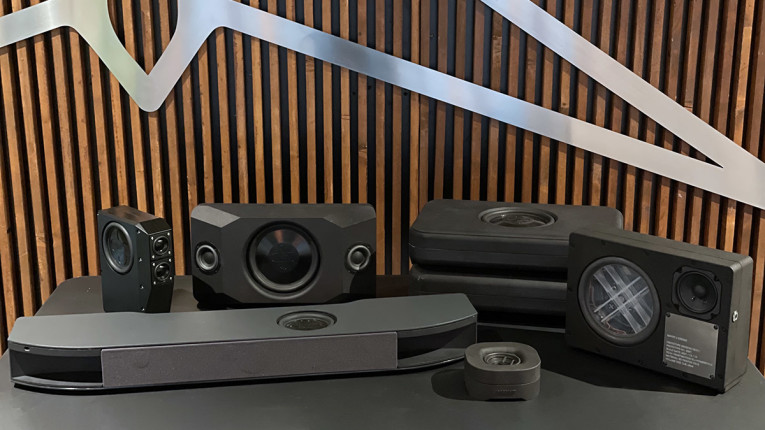
Tectonic New Next-Generation BMRs
Next is Tectonic Audio Labs, which was long-planning to make a splash at CES 2022 - the first opportunity to show the results of an intense development period, resulting in new form-factors and a whole next-generation of Balanced Mode Radiators (BMRs) drivers.
Tectonic's BMRs are long recognized for its wide directivity output up to the highest frequencies from a single transducer, ensuring clear intelligibility even in very compact configurations. This is the reason why BMRs have found success in unusual applications such as smoke alarms, and are adopted in sophisticated integrated hi-fi systems from Naim or Q-Acoustics, or in soundbars and smart speakers from large volume manufacturers. Tectonic continues to optimize the basic concepts of the BRM technology, mainly using the market knowledge that these implementations are providing to create iterations that are more powerful, more compact, or more cost-effective. And Tectonic is finally offering BMRs in new square, elliptical, and rectangular configurations.
At CES 2022, the company was showing rectangular BMRs used in the Katana Low-Profile Soundbar - custom BMR High Aspect Ratio Panel (HARP) transducers, allowing extra audio performance with LCR envelopment in a compact format. These are the latest generation of BMRs to reach the market and deliver full-bandwidth wide directivity over both axes. The long form-factor allows the drive unit to be positioned discretely without compromising the acoustic performance. At the company's suite in the Venetian, Tectonic was showing its latest generation of very compact, round-shaped BMRs in a conference speaker that was able to reproduce music in powerful room-filling sound, truly showing-off the abilities of the technology.
But the big highlight was the first public demonstration of the latest Tectonic BMR-k drivers. These manipulate the structure and distribution of diaphragm bending wave modes, enabling the transducer designer to adjust the radial locations of nodal lines while preserving the beneficial acoustic characteristics of BMRs. Essentially, these BMR-k drivers allow designers to optimize the response according to very specific criteria, maintaining Smooth Sound Power Response (SWL) and wide directivity in full-range and mid-high-frequency units.
At CES 2022, Tectonic was showing examples of Mid-HF BMR-k speakers that offer greater flexibility in design, more diaphragm material choices, and smaller motor design for similar performance, manufacturable on existing speaker lines at a lower cost. These drivers are expected to be available mid-2022, and will be followed by BMR-k models extending the frequency range.
As mentioned by audioXpress, Tectonic also supported a soundbar demonstration using Bending Wave technology by Audioscenic Limited, a 3D audio technology startup from the UK. At CES 2022, Audioscenic demoed its adaptive beam steering technology using Tectonic full-frequency BMRs to generate a large, natural-sounding audio experience from anywhere in the room.

A reference in this same field needs to go to Resonado Labs, the startup company that since its first showing at CES 2020 has not stopped investing in the development of its core Flat Core Speaker (FCS) technology. With major clients already announced in 2021 - Airstream, Hyundai, and Lippert are examples of companies using Resonado's patented linear motor design - Resonado attended CES targeting large-volume consumer applications, such as soundbars and compact home audio systems.
The Chicago, IL-based company used CES 2022 for its first public demonstration of the products developed for Hyundai and undisclosed consumer brands featuring FCS technology, designed to replace traditional round speakers with slimmer (oval or racetrack) form-factors that provide improved efficiency. Instead of using the same old cylindrical magnet with a cylindrical voice coil magnet assembly attached to a conical diaphragm, Resonado developed a motor with bar magnets and a flat voice coil attached to a flat racetrack diaphragm. The result allows smoother force distribution that results in better sound from a thinner, more compact package.
At CES 2022, for the first time in a booth, the company demonstrated a slim soundbar with a cinematic sound experience that doesn’t need a separate subwoofer, an ultra-narrow side-firing solution for premium televisions, a powerful smart speaker, and even an experiential armchair with immersive audio.

Another booth that clearly deserved attention - as it always does - is the Fraunhofer Institute for Integrated Circuits IIS, which used CES 2022 to demonstrate important evolutions of cutting-edge technologies and standards efforts, integrated into sophisticated products.
At CES 2022, Fraunhofer IIS had the world premiere of the upHear Smart Speaker Rendering solution. This new solution turns individual smart speakers into clusters, which together create an immersive audio experience from any type of content. The system has the ability to automatically adapt the rendering to an arbitrary number of smart speakers of varying sizes, speaker positions, and listening situations. In combination with spatial audio content delivered through immersive music services such as MPEG-H based 360 Reality Audio, the upHear smart speaker rendering demonstration showed how it is possible to generate compelling 3D audio to any home.
The Fraunhofer upHear Immersive Audio Virtualizer is a codec-agnostic audio post-processing technology that brings 3D sound to mass-market consumer devices such as soundbars and smart speakers. At CES, a new compact immersive soundbar rendering solution was demonstrated.
Also interesting is the Fraunhofer upHear Spatial Audio Capturing algorithm that has been designed to significantly improve the sound capture capabilities of professional and consumer 360° cameras and mobile devices using built-in microphones. And the team at CES 2022 was also showing the upHear Voice Quality Enhancement, a microphone processing technology that can be integrated into any voice-enabled ecosystem and removes noise and interfering sounds from the microphone signals, it extracts the user’s voice and restores intelligibility even in demanding acoustic environments.
Another great reason to visit the Fraunhofer booth was to listen to demonstrations of the latest xHE-AAC and LC3/LC3plus audio codecs.
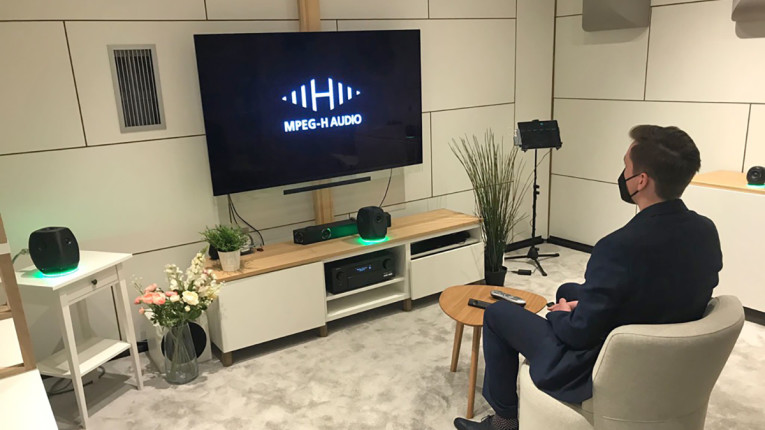
Finally, I need to reference the presence of Silentium, the innovative audio processing company that we visited at CES 2020, and that this year for the first time was also demonstrating its technologies in public, on the show floor - at the Israel pavilion in the Eureka Park.
Silentium was showing an example of its Active Noise Control (ANC) technology to remove unwanted noise with examples played back through two speakers. This is a unique noise removal/control and sound management technology using innovative algorithms that adaptively follow the changes in the noise spectrum, eliminating up to 90% of a sound – no matter its source. The result is a small, low-cost highly effective solution for low/medium-frequency noise, producing successful commercial solutions across many applications, including for industrial and automotive.
The other very interesting Silentium solution (not demonstrated at the booth) is the Quiet Bubble, an implementation of the same technology that actively reduces external sounds in order to create personal zones. Using Silentium's latest Active Acoustics technologies, this allows creating quieter cabins and personal sound spaces for car drivers and passengers or office spaces.
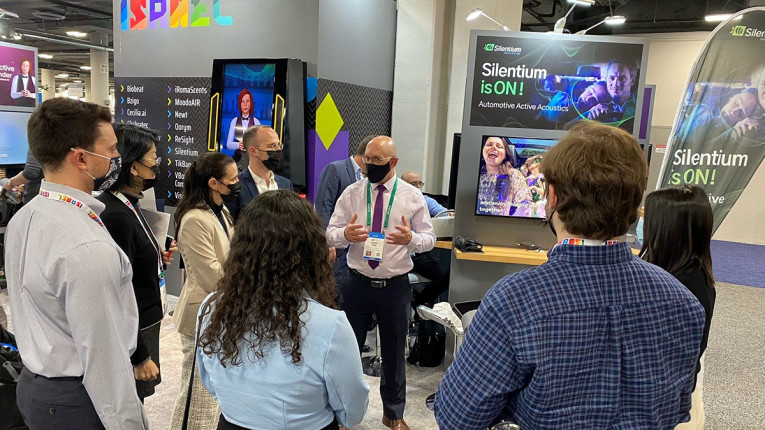
In fact, the audioXpress CES 2022 coverage so far is looking exciting, starting with the surprise announcement from GaN Systems and Dutch audio innovator Axign, debuting a new groundbreaking GaN-based 500W Class-D audio amplifier. This reference design combining GaN power transistors and Axign’s Class-D controller, was certainly one of the major attractions for anyone interested in high-quality audio attending CES 2022. And it will continue to be for whatever show might be next.
Those in the industry unable to attend CES in person could access the show online through January 31. Web Summit was selected as the digital platform provider for CES 2022 and the platform used benefits both in-person and digital attendees. Exhibit sales for CES 2023 are already off to a strong start, with CES scheduled to return to Las Vegas from January 5-8, 2023, again earlier in the year but back to the normal four days (we all hope).
www.CES.tech
This article was originally published in The Audio Voice newsletter (#359), January 13, 2021.





